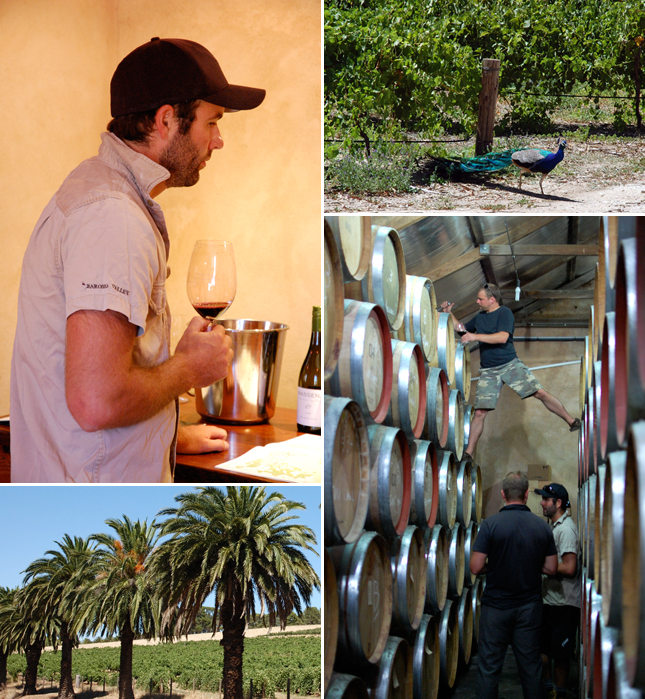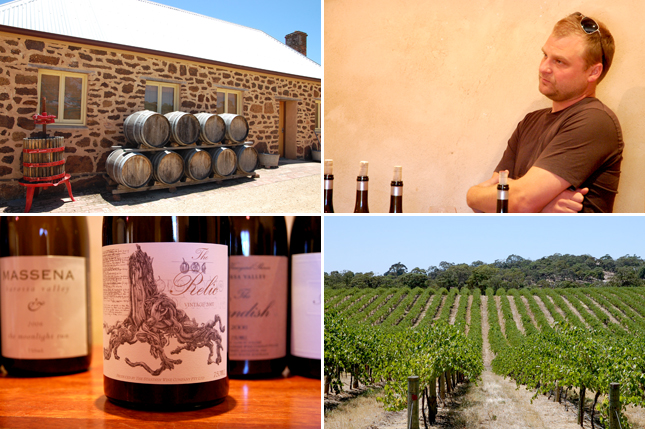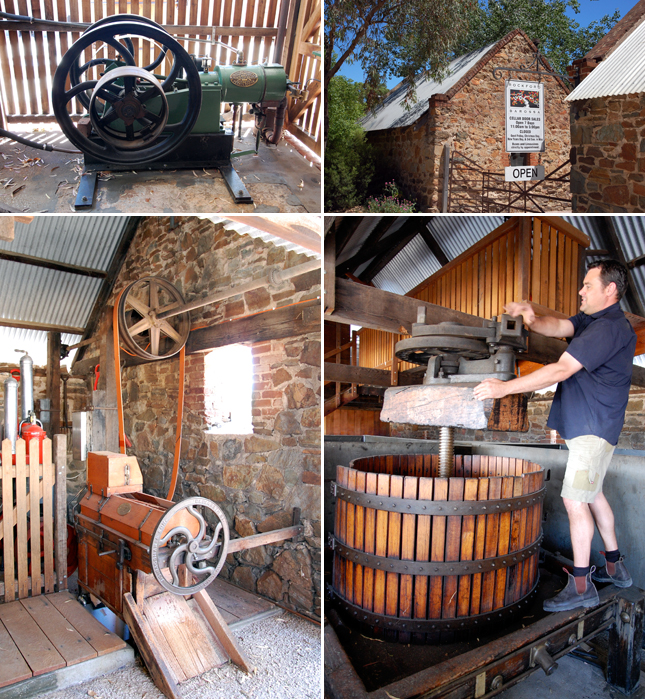The New Barossa Valley Winemakers

The acquisition of vast land holdings in the Barossa Valley began around 1830. The trend began when a wave of moneyed English settlers, followed by ambitious Prussians, then Silesian¹ farmers swept through the Eden and Barossa Valleys, all of them snapping up parcels of land and converting them into farms and townships. A little later, when it became clear that this was a decent grape growing region, vineyards began to replace grazing land and cornfields. Some of the main players in this “old boy network” land grab consisted of a veteran campaigner against Napoleon, a few company chairmen types with ranching interests and a bunch of industrious Germans. Enough Germans that by the turn of the century one was as likely to hear German being spoken as English.²
It was William Light, a veteran on the Napoleonic wars who played an integral part in the development of the Barossa and who gave the valley its name. After the Peninsula War, Light went on to become the Surveyor General for the Province of South Australia. While looking for a suitable place to cross the Murray River he found a valley in need of a name. To honor his former commander's victory over the French in 1811 Light named the valley after the decisive battle that was fought at Barrosa, or the Hill of Roses in Spain. It only took a few years of more incorrect than correct spellings and that one “R” was replaced by another “S” to give us the contemporary spelling: Barossa. It was also Light’s survey work that enabled his fellow Englishmen to draw out plots then sell them to arriving settlers.

Many of those original land-owning families who made the Barossa Valley into Australia’s preeminent wine region are the same today as they were in the late 1800s. The work that was started by men like Johann Gramp, who created the first commercial winery, Orlando Wines in 1847, continues today in the form of the Jacob’s Creek line — which is owned by Pernod Ricard. Or Joseph Seppelt whose original vineyard holdings still engulf a large section of the valley and whose organization founded in 1851, now makes wine for the Foster’s Group. William Salter, whose Saltram winery began in 1844, is now also a part of the Foster’s Group portfolio. As is the Wolf Blass product line; though Wolfgang Blass is a relative upstart who established his business in 1966. There are plenty more, like the third and fourth generation grape growers who banded together to form Barossa Valley Estate — which is owned by Constellation Brands. A tiny few, such as Henschke, Bruge and the Smiths of Yalumba (Australia’s oldest family owned winery) remain family owned though this has not made them immune to the urge to expand in the same manner as their corporate competitors.
The biggest changes to the Barossa wine industry began to take place in the 1980s. At the start of the decade a measly 2% of all Aussie wine produced was exported. Then something happened. Australian wine, predominately, Barossa Valley wines, got the attention of the English wine buying market, mostly because it was cheap. As the wine consumer grew more interested in the Aussie product many of the already huge wineries of the Barossa stopped making rot-gut fortified wines and switched to still wines as they expanded to accommodate the increased international demand. During these years several wineries turned themselves over to corporations or bought more land, some of it far from Barossa, and doubled their vine planting. From 1985 to 1999 exports multiplied by 100 times. In 1999 the industry nationwide cracked the AU$3 billion mark in export business. To demonstrate the leap in exports: total US revenue from wine exports in 1999 totaled $548 million. By 2000 Aussie wine was selling at a rate of 300,000 bottles a day in England. Through increased production, corporatization and innovative use of mechanization, like the machine grape harvester and rotary fermenter (a rotating cylinder that shortens ferment times down from around 2-3 weeks to five days) Australia was able to literally flood the market with affordable wines that were pleasing to most palates.

Despite the booms and busts the Barossa has held its global position as the most famous and significant wine region in Australia, though it seems now that it, along the rest of South Australia retains our awe less because of the quality of the wines produced and more from the astronomical amount that pours out. In a good year like 2003-04 about 194 million gallons (733 million liters) of wine were produced keeping South Australia at the top of wine production and exportation in the nation. In 2009 the state shipped out 118 million gallons (448 million liters) worth AU$1.574 billion.³
Through the years of incredible growth there were a handful of Barossa winemakers and vineyard owners who managed to, or just plain refused to, be lured by the quick cash to be gained from taking short cuts and making mostly over-hyped bulk wine. Robert O’Callaghan who founded Rockford Wines is locally regarded as the individual who most assertively bucked the trend. Unlike his larger, more industrialized competitors O’Callaghan opted to stay small and his operation still makes wines by hand using minimal equipment and antique gear, like his wooden stemmer and basket press that date back to the days of the valley’s settlement.
Over time O’Callaghan won converts, built a loyal customer base and helped start the careers of David Powell, who went on to launch Torbreck and Chris Ringland, founder of Three Rivers. Both winemakers are now world renowned and both handcraft wines in the same slow, deliberate manner as O’Callaghan.

Now there is a third wave in the Barossa. Most of this generation have worked for or alongside guys like O’Callaghan, Powell and Ringland. Most have also worked vintages in France, Italy, Spain, South Africa and California. And each has seen enough of the wine industry to aver that wine making comes first. Fraser McKinley, one of the wine makers at the Standish Wine Company and maker of his own Sami-Odi wines said, “Wine making for us is extraordinarily simple. We learned from guys like David Powell, who formed their views from working with Robert at Rockford.” Which means forming solid relationships with grape growers, thoughtful, oftentimes biodynamic, vineyard management, overseeing production from start to finish and making wine that reflects the place.
Ben Radford, now the chief winemaker at Rockford is one of these new faces on the Barossa scene. He along with his wife Gill, who makes her wines under the Radford label, own some of the oldest vineyards⁴ in the region, if not the world, and work their land bio-dynamically. The couple met in Stellenbosch, South Africa and moved their operation back to Australia firm in their belief that there is more to Australia and the Barossa than just mass produced wine.
Another of the third wave is Dan Standish. He founded the Standish Wine Company in 1999 and like many in this group found that the personal touch makes for better wine. “Each batch is treated differently and separately,” says Standish. “There’s no typical regime. We look at our wines and we taste and the wine tells us when it’s ready.” He attributes his belief in wines being able to speak for themselves, in part, to Robert O’Callaghan. “He is sort of the godfather of the rebirth of old world winemaking practices in the Barossa Valley. He was the first one to step away from the technical winemaking methods that said, you must add tannin, you must add acid, you must do this and the numbers must add up to this. Now there’s a lot of guys in this valley who are using the old world techniques and it all goes back to Rockford, for sure.”

Presently, there are producers in the Barossa enduring another bust period brought on mainly by corporate shortsightedness. The major players in the industry have found themselves with a glut of wine producing up to 40 million more cases than they are selling. Analysts report that if the wine industry hopes to operate profitably it will have to cut at least 10% of Australia’s 437,000 acres (177,000 hectares) of vineyard from production — 10% amounts to an area slightly smaller than the state of Rhode Island. At the moment there is no market for what are sometimes referred to as “factory wines” despite appealing to Australian’s patriotic side and pleading with them to “drink local.”
Interestingly, producers like Rockford, for example, who move 70 to 80% of their wine via direct sales through their cellar door/tasting room, suffer from the opposite of a wine glut, selling out vintages regularly. Nationally the demand for better quality is apparent and internationally consumers of Aussie wine have tired of what Brain Croser, former owner of Petaluma wine company calls, “branded commodity wines.” While the big production wineries have seen an overall 6.8% drop in sales “icon” and “super premium” sales remain steady. “Some of us in the Barossa have been quite lucky up to this point,” says Fraser McKinley, “I guess you better touch wood and hope it stays that way.”
Wine tasting with Dan Standish and Fraser McKinely
1. The Silesian immigrants came from what is now part of Poland, Germany and the Czech Republic. Despite exaggerated claims, only about 5% of the newly arrived Silesians to South Australian had emigrated to escape “religious persecution” because of changes made by Kaiser Fredrick Wilhelm III to the “Old Lutheran” faith. The nation-state of Silesia existed in one form another until after WWII when it was absorbed into Soviet controlled Poland. Today Silesian regions remain however the German speaking population has dwindled due mainly to post-WWII politics.
2. There are still pockets of Barossa Deutsch speakers and at least one German speaking radio station in the Barossa Valley. During WWI and WWII the Australian government discouraged German language use and closed schools that taught lessons in German.
3. In 1999 South Australia produced nearly half of the nation’s wine output. Today, as a state, SA accounts for 21% of the national output. This is an interesting indicator of just how rapid the growth of the wine industry in other Australian wine regions has been.
4. Some of the oldest vines in the world can be found in South Australia. Given the sandy soils in the valley the region has never been plagued by the phylloxera louse. Some vines are around 120 to 125 years old. The Freedom Shiraz vineyard, planted in 1843 by immigrant Christian Auricht is thought to be the oldest Shiraz vineyard. The vineyard is owned by Langmeil Winery who recently bottled the 164th vintage from this block.
Contact information for wineries mentioned in this story:
Rockford Wine
Krondorf Road
P.O. Box 142
Tanunda, South Australia 5352
Torbreck Wines
P.O. Box 583, Tanunda SA 5352
Lot 51, Roennfeldt Road,
Marananga, SA, 5355
Radford Wines
RSD 355 Eden Valley
South Australia 5235
Australia
Standish Wine Company Pty. Ltd.
P.O. Box 498
Angaston, South Australia
5353
Info@standishwineco.com
or
Massena Vineyards Pty Ltd
P.O. Box 54,
Tanunda SA 5352
Sami-Odi Wines
P.O. Box 280
Grunock, SA 5360






 Share Article
Share Article